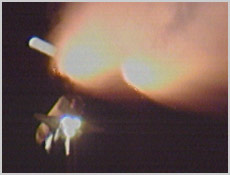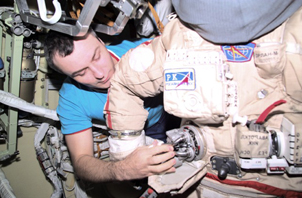Cosmonaut Vladimir N. Dezhurov, Expedition Three flight engineer, prepares the Russian Orlan space suit for an upcoming space walk from the Pirs Docking Compartment on the International Space Station (ISS).
Click on image for full size
Courtesy of NASA
A Walk in Space - Preparing to Leave the ISS
News story originally written on November 10, 2001
The third crew's stay onboard the International Space Station (ISS) is coming to a close. Commander
Frank Culbertson, Pilot Vladimir Dezhurov and Flight Engineer Mikhail Tyurin have been onboard the space station since mid-August. The fourth crew, made up of team members
Daniel W. Bursch, Yuri I. Onufrienko and
Carl E. Walz, will arrive to take their place onboard the space station in December 2001.
Before the third crew departs from the ISS, preparations are being made for their third and final space walk. The space walk will take place on November 12, 2001. The object of this space walk, as it was with the previous two space walks, is to make electrical connections between Pirs and the Zvezda Service Module. Pirs is the newly-arrived Russian Docking Compartment. Space walkers will also install equipment outside of the station.
November 2, 2001, marked one year of humans continuously being onboard the ISS. During this year, 14 spacecraft have visited the ISS and 18 space walks have been made. Also during this year, the station has increased in size with the addition of the Destiny Laboratory, the U.S. solar arrays, the Quest Airlock, Canadarm2 and the Pirs Docking Compartment.
You might also be interested in:

The Shuttle Atlantis had a perfect launch on February 7, 2001. It lifted off just after 6 p.m. EST, carrying 5 astronauts and the Destiny laboratory to the International Space Station (ISS). The astronauts
...more
It was another exciting and frustrating year for the space science program. It seemed that every step forward led to one backwards. Either way, NASA led the way to a great century of discovery. Unfortunately,
...more
The Space Shuttle Discovery lifted off from Kennedy Space Center on October 29th at 2:19 p.m. EST. The weather was great as Discovery took 8 1/2 minutes to reach orbit. This was the United States' 123rd
...more
A moon was discovered orbiting the asteroid, Eugenia. This is only the second time in history that a satellite has been seen circling an asteroid. A special mirror allowed scientists to find the moon
...more
Will Russia ever put the service module for the International Space Station in space? NASA officials want an answer from the Russian government. The necessary service module is currently waiting to be
...more
A coronal mass ejection (CME) happened on the Sun early last month. The material that was thrown out from this explosion passed the ACE spacecraft. The SWICS instrument on ACE has produced a new and very
...more
J.S. Maini of the Canadian Forest Service called forests the "heart and lungs of the world." This is because forests filter air and water pollution, absorb carbon dioxide, release oxygen, and maintain
...more















